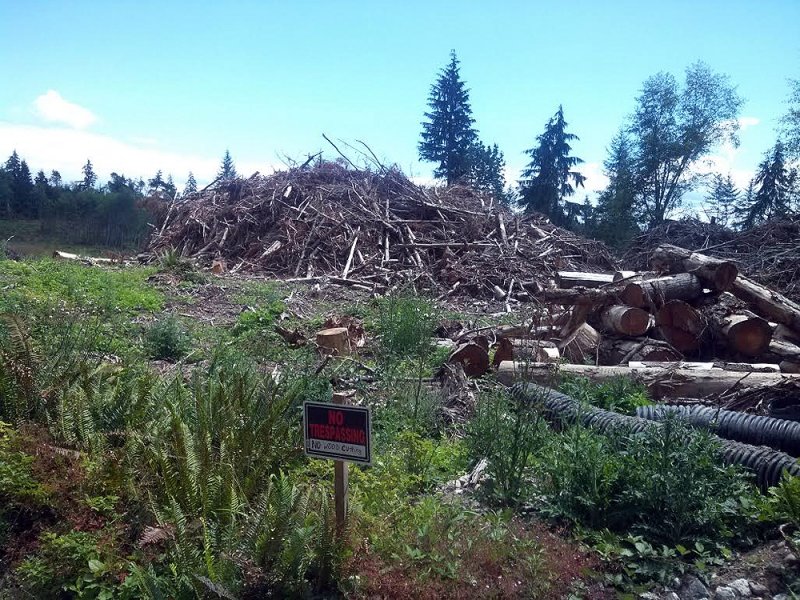 A clear-cut and slash pile on Rouse Road, seen here last summer. Photo: Lisa Bryan, KP News
A clear-cut and slash pile on Rouse Road, seen here last summer. Photo: Lisa Bryan, KP News
Editor’s note: This is the second of a three-part series on logging on the Key Peninsula. The first article provided an overview of permitting requirements and an example of what happens when the rules are ignored. This article focuses on the practice of clear-cutting and the final article will discuss alternative forestry practices. Part 1 can be seen here
The couple had land they loved that was covered with trees, but when a medical emergency came up, they needed cash. “We hoped to sell 20 acres to someone who we knew would not log it,” said one owner, “but when that fell through, we looked at other options.” Although she asked to remain anonymous, the owner shared her experience with the KP News.
“We knew the value of the land was about $7,000 an acre. My husband spoke with a logging company clear-cutting another parcel in the area. They came to evaluate our timber and said it was worth $8,500 an acre, much more than we had expected. The logging company would submit the permit, harvest the timber and do some basic cleanup for 50 percent of the stumpage fee (the value of the standing timber). We were responsible for the excise tax and we could pay them to coordinate replanting.
“To us, the decision was pretty clear. We could sell the land to someone else who would probably clear-cut it or we could hire someone to log it, get about $4,000 an acre after expenses, and still own the land.”
The couple signed a contract and logging began a month later. It took three weeks to complete the clear cutting. They paid a 5 percent excise tax, with 1 percent going to the state and 4 percent to the county. Stumps were left in place (as is required) and the company made large piles of slash since burning to clear land is not allowed in Pierce County. The couple identified a trustworthy person to take what he could from the debris to sell as firewood. They hope to have the lot replanted this winter before scotch broom and other plants make survival of seedlings difficult.
Tom Van Slyke, whose family has been on the Key Peninsula since the 1880s and whose grandfather owned the first sawmill in the area, noted that by 1900 there were no trees left on the Peninsula. “Everything here is second or third growth,” he said.
Aileen Nichols, Washington State Department of Natural Resources (DNR) field forester for South Puget Sound, reviews all requests for logging permits. She confirmed that logging on the KP has increased. The 52 permits issued last year was the highest number approved in 10 years. There were 44 the previous year and just 26 were approved 10 years ago. She thinks that one reason for this is that logging companies have been more aggressive about reaching out to landowners.
Log prices are also nearly the highest they have been since 2005, according to Nasdaq.
Nichols, who covers Thurston, Mason, Kitsap and Pierce counties, said that the KP is unique. “Most applications from the other areas come from large landowners,” she said. “On the Key Peninsula, most parcels are smaller than 10 acres. Twenty to 40 acres is really unusual.”
There is no designated forestland on the KP. “The 1990 Growth Management Act required counties to establish a designated forestland zone,” said Adonais Clark, planner with Pierce County Planning and Land Use Services (PALS). “The county chose to establish forestland zoning only in the Cascade Foothills, although forestry is an allowed use in most zones throughout the rural areas of Pierce County.”
However, there is a Designated Forest Land tax program for land devoted to growth and harvest of trees. It is limited to parcels of at least 5 acres; owners are required to have a timber management plan and must pay a compensating tax if there is a change in use. Qualifying parcels are taxed at a value of $200 or less per acre.
The state issues the vast majority of the permits for logging on the peninsula, according to Clark. If the owner plans to convert to other use, the county must be involved.
Once land is logged, the owner is required to have a plan for forest renewal. Stumps are left in place and most plans call for replanting. At least 190 seedlings per acre must be established within three years. Practically speaking, according to the Washington Contract Loggers Association website, this means planting within 12 to 18 months, before scotch broom and other plants crowd the land, at a density of 400 to 500 seedlings to allow for losses. One logger on the Key Peninsula uses natural regeneration, leaving at least eight seed trees per acre.
Nichols said that not all logging companies are created equal. Some leave the site in better condition than others. Some are more explicit about how or if they will help with replanting, though the owner is responsible for the cost. If a landowner does decide to log, she suggested asking others for recommendations. But there are other options.
As the landowner who had her 20 acres clear-cut noted, “$4,000 an acre for lumber that will take another 60 years to mature doesn’t actually sound like much money.
Concerns about a logging operation can be reported to the regional DNR office at 360-825-1631.
UNDERWRITTEN BY THE FUND FOR NONPROFIT NEWS (NEWSMATCH) AT THE MIAMI FOUNDATION, THE ANGEL GUILD, ADVERTISERS, DONORS AND PEOPLE WHO SUPPORT INDEPENDENT, NONPROFIT LOCAL NEWS